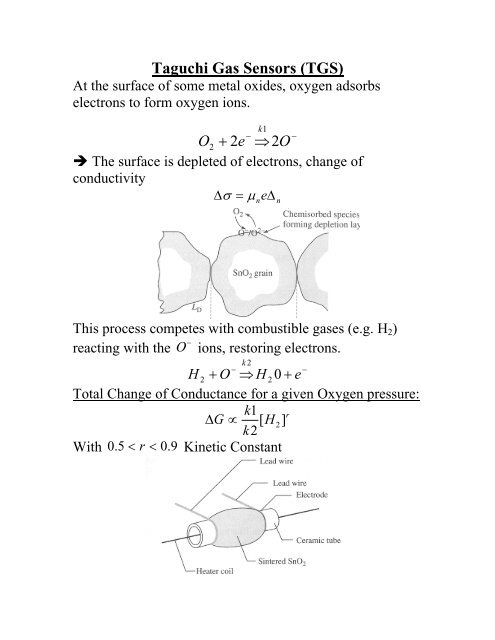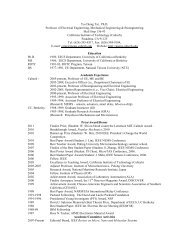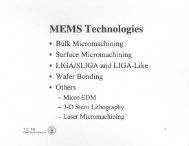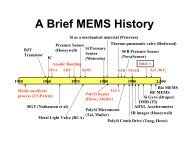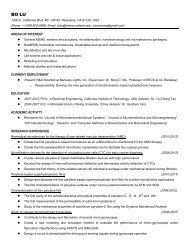Taguchi Gas Sensors (TGS)
Taguchi Gas Sensors (TGS)
Taguchi Gas Sensors (TGS)
Create successful ePaper yourself
Turn your PDF publications into a flip-book with our unique Google optimized e-Paper software.
<strong>Taguchi</strong> <strong>Gas</strong> <strong>Sensors</strong> (<strong>TGS</strong>)<br />
At the surface of some metal oxides, oxygen adsorbs<br />
electrons to form oxygen ions.<br />
− k1<br />
−<br />
+ 2e<br />
⇒2O<br />
O2<br />
The surface is depleted of electrons, change of<br />
conductivity<br />
∆ σ = µ<br />
n e∆ n<br />
This process competes with combustible gases (e.g. H 2 )<br />
−<br />
reacting with the O ions, restoring electrons.<br />
k 2<br />
−<br />
−<br />
+ O ⇒ H<br />
2<br />
0 + e<br />
H<br />
2<br />
Total Change of Conductance for a given Oxygen pressure:<br />
k1<br />
r<br />
∆ G ∝ [ H<br />
2]<br />
k2<br />
With 0 .5 < r < 0. 9 Kinetic Constant
<strong>TGS</strong> Characteristics<br />
<strong>TGS</strong> can be optimized for various gases:<br />
Disadvantage: For high sensitivity, <strong>TGS</strong> need heating<br />
large power consumption (several hundreds mW)
ADFET <strong>Gas</strong> Sensor (Adsorbtion Field Effect<br />
Transistor)<br />
MOSFET-based structure with extremely thin oxide (5nm).<br />
Adsorbed molecules in the oxide modify the electric field,<br />
and therefore the current<br />
Advantage: built-in gain<br />
Disadvantage: Lack of selectivity, Noise
Palladium-Based Hydrogen <strong>Sensors</strong><br />
Pd-Gate MOS (Lundström, 1975):<br />
-Palladium gate and thin tin oxide (about 10nm)<br />
Hydrogen atoms diffuse to the Pd/Oxide interface<br />
and act like a dipoles, thus modifiying the Pd workfunction.<br />
[H 2 ] modifies the threshold voltage.<br />
Q<br />
4qN<br />
ss<br />
Aε<br />
0ε<br />
sψ<br />
B<br />
V = ϕ − + 2 ψ +<br />
TH<br />
ms<br />
C<br />
ox<br />
B<br />
C<br />
Basic Measurement Circuit:<br />
ox<br />
I<br />
d<br />
C<br />
W<br />
Vg = V<br />
ox<br />
2<br />
= µ d<br />
( Vgs<br />
−VT<br />
)<br />
L<br />
<br />
TH<br />
µ CoxW<br />
+<br />
I<br />
L<br />
Measured Voltage Shift:<br />
∆V<br />
g<br />
=<br />
∆V<br />
MAX<br />
1+<br />
C<br />
C<br />
PH<br />
PH<br />
2<br />
2<br />
/<br />
/ PO<br />
PO<br />
2<br />
2
Pd-MOS Response Curves<br />
This kind of device can reach a sensitivity of 1ppm in<br />
air.
ISFET (Ion-Sensitive FET)<br />
Adsorbed Species modify the effective Gate-Voltage.<br />
ISFET pH sensors can reach sensitivities of 0.001pH<br />
unit.
Selective ISFETS<br />
Ion-selective membranes can be added above the gate<br />
to filter specific ions.<br />
The membrane can include biological molecules (e.g.<br />
enzymes) to detect biological compounds<br />
”Bio<strong>Sensors</strong>”


